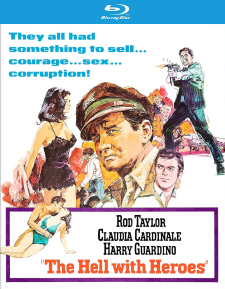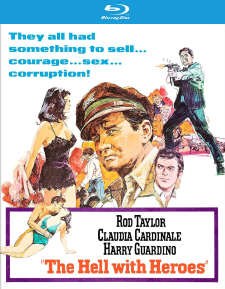Hell with Heroes, The (Blu-ray Review)

Director
Joseph SargentRelease Date(s)
1968 (January 9, 2024)Studio(s)
Universal Pictures (Kino Lorber Studio Classics)- Film/Program Grade: B
- Video Grade: A-
- Audio Grade: A-
- Extras Grade: B
Review
William Wyler directed the definitive film about returning World War II veterans, The Best Years of Our Lives in 1946. That film centered on three discharged servicemen reuniting with their families and adjusting to being back in their former lives. Twenty-two years later, a different director tackled The Hell with Heroes, focusing on a pair of decorated war heroes, former air force buddies who did not go home. Preferring to stay in North Africa, they established a modest business until they found themselves involved with an international smuggling ring.
Set just after the end of World War II, The Hell with Heroes stars Rod Taylor (The Time Machine) as Brynie MacKay, a wartime pilot turned cynical, and his partner and former copilot, Mike Brewer (Peter Deuel, Generation) Together they run a cargo plane for hire and spend their leisure time with days on the beach and evenings in night clubs, enjoying booze, belly dancers, and pretty women.
Their easygoing lifestyle is interrupted when they accept a job to transport goods for big-time black market smuggler Lee Harris (Harry Guardino, Dirty Harry). When MacKay learns their cargo is contraband cigarettes, he extracts a larger fee from Harris. The smuggler retaliates by hiding narcotics in the plane and reporting McKay and Brewer to Col. Wilson of U.S. Counterintelligence (Kevin McCarthy, Invasion of the Body Snatchers). The plane is impounded and MacKay, backed into a corner, makes a deal with Harris to fly several more illegal missions in exchange for getting the plane back and the chance to own it outright. On one of these missions, violence erupts, leading to a climactic confrontation between MacKay and Harris.
Harris’ mistress, the beautiful Elena (Claudia Cardinale, The Professionals) is attracted to MacKay and comes to his aid. The attraction is mutual. The war has damaged them both and they share that bond. Their relationship soon becomes romantic, complicating MacKay’s dealings with Harris.
Director Joseph Sargent (The Taking of Pelham One Two Three) has combined an adventure with an examination of a man’s inner conflict in a very personal story spiced with action. Shot at Universal and nearby locations, the film tries to duplicate places in North Africa and Paris but it’s obvious that these scenes were shot on or near the back lot. Quincy Jones’ jazz score gives the film a nice rhythm and enhances the action sequences.
The plot is good guys vs. bad guys material, but Taylor infuses sensitivity and intelligence into his role as a wartime soldier transitioning from stressful battle conditions to civilian life. Taylor had an active movie career at the time and was a good fit for MacKay—looking rugged, tough, and romantic. He’s believable as man trying to extricate himself and his best friend from danger by making a deal with a ruthless antagonist.
Cardinale is stunningly beautiful, photographed seductively, and showcased in lush gowns by Jean Louis. Her romantic scenes with Taylor have some heat but she’s otherwise wooden, with a blank stare on her impeccably made-up face. The film’s weak link, Cardinale fails to generate interest or empathy for her character.
Guardino seems wrong for the role of Harris for a few reasons. First, he looks too refined to be the violent smuggler he portrays. Second, his manner of speaking projects little menace. When he threatens, he seems to be reciting rather living the role. And physically, he seems a poor match for the rugged Taylor. Too much of Guardino’s “nice guy” quality comes through, making his performance as a murderous international smuggler hard to accept.
Deuel (spelled incorrectly as “Duel” on IMDB) plays MacKay’s sidekick and doesn’t have much to do. MacKay saved Brewer’s life when they piloted together during the war and they’ve shared a camaraderie ever since. Good looking and bandying easy repartee with McKay, Brewer is almost a stock character, on hand mostly as a plot device in a climactic scene that moves the narrative in a more violent direction.
The Hell with Heroes was shot by director of cinematography Bud Thackery on 35 mm color film using the Techniscope process and presented in the aspect ratio of 2.35:1. The Blu-ray release features a brand new HD master from a 2K scan of an interpositive. There are no imperfections such as dirt specks, scratches or emulsion clouding to impair viewing enjoyment. Overall quality varies. The stock airplane battle footage is grainy and not as sharp as the studio-shot scenes. Details, such as whiskers on MacKay’s face, furnishings, uniform insignia, and markings on the plane are well delineated. The deeply saturated Technicolor images are showcased best in the early scenes of MacKay and Brewer on the beach and in nightclubs. Color palette is broad, ranging from bold primary hues to earthier tones. Stock footage has been tinted to blend with new footage showing the two pilots in action during the war. A key night scene in the desert was filmed day-for-night. A helicopter was used to film vehicles moving through the desert. High angle shots in the Paris sequence provide wide views that stand in for the real city. A few aerial views show MacKay’s cargo plane in flight.
The soundtrack is English 2.0 mono DTS-HD Master Audio. Optional English subtitles are available. The mono sound mix is credited to Westrex Recording System. Dialogue is clear and distinct for the most part, though it’s somewhat overshadowed by Quincy Jones’ jazz score in the nightclub scenes. Sound effects include the dual propellers on MacKay’s cargo plane, staff car engines, gun shots, fists pummeling bodies, bodies crashing into furniture, and ambient crowd noise in the streets outside the nightclub. Jones’ score enhances the proceedings and helps keep the narrative flowing when the film’s pace sags. Some scenes set outdoors but filmed in the studio have a slight echo-y quality.
Bonus materials on the Region A Blu-ray include the following:
- Audio Commentary by Filmmaker/Historian Steve Mitchell and Author Steven Jay Rubin
- Trailer (2:31)
- The Great Escape Trailer (2:45)
- The Train Trailer (4:26)
- The Devil’s Brigade Trailer (3:47)
- Kill a Dragon Trailer (1:44)
- The Pink Jungle Trailer (2:42)
- White Lightning Trailer (2:26)
- The Taking of Pelham One Two Three Trailer (2:33)
Audio Commentary – The Hell with Heroes is described as an “airplane smuggling movie.” Stock World War II footage sets the tone: What happens to guys in the air force after the war? MacKay and Brewer might have been suffering from what today is referred to as PTSD, and the film may have had special relevance for Greatest Generation veterans. The art direction reflects the studio style, a throwback to old Hollywood. Universal was trying to hold on to the past. In 1968, the studio was still putting young actors under contract, most of whom would find success on TV rather than in feature films. Peter Deuel would later play Hannibal Hayes on the TV series Alias Smith and Jones. Earlier working titles for The Hell with Heroes included A Time for Heroes and Run, Hero Run. Exteriors were shot in the desert about 30 miles from the studio. Universal had a huge store of “rolling stock,” including half-tracks, tanks, and other vintage vehicles. Harry Guardino usually played good guys and may not have been the best fit for the role of smuggler Lee Harris. “He was so East Coast.” The “junkyard sort of look” reflects MacKay’s and Brewer’s lifestyle. Australian Rod Taylor shows no evidence of his native accent and always looked good in uniform. He had good comedy and romantic chops along with a regular-guy quality. Taylor was a ladies man and was married three times. Films in the 1960s had a growing sexuality because the world was changing. The Hell with Heroes “barely made a ripple at the box office,” and both commentators note that they never met anyone who had seen the film in a theater. Director Joseph Sargent did an effective job of making Universal look like Paris thanks to the studio’s ability to tailor its facilities to the production. Cardinale’s chemistry with Taylor is better than that between Guardino and Cardinale. There’s a tenderness to Taylor. The amount of blood shown is greater than in most films of the period. More graphic films, such as The Wild Bunch and Bonnie and Clyde, “were on the horizon.” Rod Taylor liked doing his own stunts. Kevin McCarthy had a patrician, educated look, perfect for his role. The commentators close their discussion by saying that it was enjoyable “spending some time with old friends.”
In The Hell with Heroes, World War II is in the rear-view mirror but its effects on the former fighters remain very much present, represented by the main characters. The loyal friends McKay and Brewer are trying to put the past behind them, but getting involved with an international smuggler forces them to move out of their comfort zone and face unpleasant realities. With a romantic sub-plot that fits awkwardly into the main story line, a leading lady who’s little more than a gorgeous department-store manikin, a villain who’s less than up to the job, and locations that are not convincing, the film never rises above what would have been a B picture back in the 40s or 50s—the second feature on a double bill. It’s mildly entertaining but doesn’t leave much of an impression.
- Dennis Seuling

